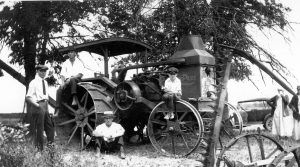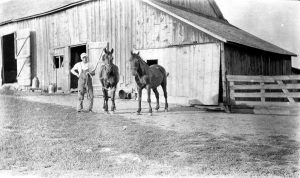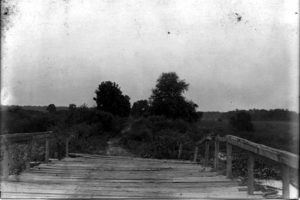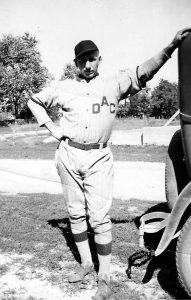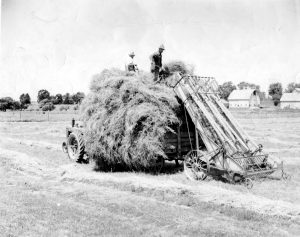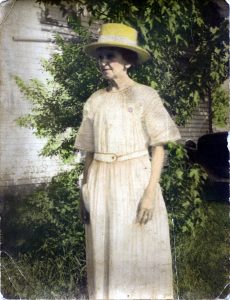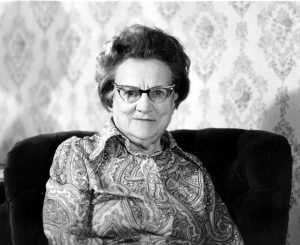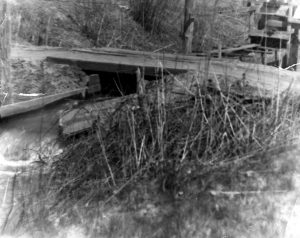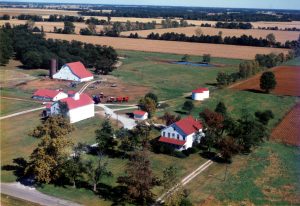Dick and Irene Evans and Mrs. Emily (Howard) Evans
THE SETTLING OF THE GRAND MARSH OF THE KANKAKEE
RIVER
Interview by Laverne Terpstra, Transcribed by Shirley Zeck
December 6, 1994
We moved here in 1944 and I (Dick) went to the service soon after. My brother Jack was already in the service. We came home after the war in 1946 and helped dad on the farm here.
Prior to the time we moved here the farm was used as the headquarters, I understand, for five or six thousand acres. The old house was used as a headquarters for the office and to feed the cowboys and workers. It had two big dining rooms downstairs and an office, kitchen and two bedrooms.
Upstairs there were six bedrooms, each one had an old stove setting in the corner heated by wood, coal, or whatever they had to burn. Then in the third story there was one big room the length of the house which was sixty feet.
There were all bunk beds up there. That was what the house was used for, to take care of the people and feed them. They had what they called running water. It was a horse tank up in the attic above the third floor. The water ran down with its own pressure which wasn’t very much. The water tank is still up there. They must have put it up there before they put the roof on. They had a force pump in the basement that forced the water up to that horse tank.
For the stoves in the bedrooms they had one chimney right in the corner. They could put a stove in each bedroom that way. There were four chimneys on the house. Mon says five.
When we came here we put a new roof on the house. We took all the chimneys off except one.
The basement now is under the whole house. When the Land Company owned it, it was just a small basement under the east end of the house where they kept their canned goods and the pump was down there; also a few other things. I don’t know what.
In the upstairs a nail on the wall was their closet space. When we moved here we put closets in and changed it around a little bit. We put a bathroom in. Before that there was outdoor plumbing.
They hired people to do the cooking. One of the former ones who worked here was Grace Betterton. They had different people after that. I think the Holladays did some of the work around here, (Squeek and Thelma). They told a story about him when he was a kid.
He was here for some reason. His folks must have been cooking and taking care of the house. This was before the Land Company owned it, I believe.
The hunters used this as a Club. He always told the story he was up in the back room hanging around the hunters and they would give him a nickel here and there. One guy’s gun went off and went between the other guys legs. It didn’t hurt anybody but he never quit running until he got to Kersey.
The neighbors of some of the boys (Summers) that lived in Kersey used to come over to see who could to the top of the real steep wood barn. None of them ever did. It was too steep for them.
The dining room which is now the living room was approximately thirty feet long and eighteen feet wide. They fed probably twenty people including cowboys, fence builders, and carpenters. They had a little bit of everything.
Those guys broke horses to sell. They shipped horses in here on the railroad. They would break them and sell them to farmers, etc. They used a lot of them because they has six thousand acres here they took care of. It went north to the Hodge ditch.
Out south of the Hodge ditch on a farm there they had what hey called Devil’s Hole. Cattle would get in there and they would have to pull them out with horses, ropes, etc. A lot of them they never got out. They would just keep sinking a little more at a time. That’s why they called it Devil’s Hole. It was located north of where Tom Postma lives now (14621 N 700 W).
Mom wants to talk about the mule chest. It would hold approximately twenty horses or mules. You fed them from the outside. You didn’t dare walk behind them or they would kick your hat off. They had doors that opened in front and you fed them there. We tore that down.
We tore the old chicken house down. There was another pump house and harness shop with a forge in it. They made their horseshoes there, etc. We tore that down.
We took the big horse tanks down. They were made out of cement and were twenty feet wide. There was one of them on the top of the hill north of the house.
The house and the corncrib are the two original buildings. The other buildings we tore down. Then the barn was built about ten years later. I think the house was built, near as I can tell, in 1893. I don’t know if that is right or wrong.
The barn which was built about ten years after that, we still use for cattle. We also still use some of the bins in the corncrib.
Neal Swart, brother of Leonard (Buzz) Swart, (also Jack Swart’s dad), carved his initials in that big barn up on the hill in 1920. That barn had to be there before that.
Buzz told me Neal was around eighteen when he helped feed cattle up here. The Swarts lived just about one half mile north of this farm. They were all born there.
Some more of the men that worked on the threshing ring over at the marsh when we lived there were Ben Hoffman, Martin Hoffman, Struble, Nixon, some of the Fairchilds. The pitchers got $3.00 a day for pitching bundles. The man with the wagon and hayrack and horses got $4.50 a day.
Pete Swisher, Ausie Swisher, Mose Hancock, the Swart brothers, Hanley Summers, Bert Duggins, Neal Mak, all worked there at different times. This was in July 18, 1924. That was mostly a threshing crew that went around from farm to farm. I think that the Evans’ owned the threshing machine and everybody else pitched in and they kept track of how many bushels they threshed out. They paid so much a bushel. Whoever you were working for paid the hired help.
This was taken from a time book that was kept by my grandfather J.P. Evans. (Jean Paul). J.P. Evans was Dick’s grandfather. He was married to Alice French. Her father was a doctor. We have a walnut secretary that belonged to him that he kept his medicines in.
J.P. Evans and Alice French had four boys. There names were Paul, Harve, Howard, and Don; also two daughters Grace and Lois. They came from Rockford, Illinois and moved to Indiana in 1918
J.P. Evans came to the DeMotte area with his four sons and they started farming on the farm that now belongs to Garrett Walstra. This is just north of the Hodge ditch (15771 N US 231). At that time they had 1200 acres and he farmed it with his four sons. They farmed that farm until the depression time when they lost it.
It was at that time that Howard Evans rented the farm until 1944. That’s when we moved here on 700 West. Paul and Harve moved to Hebron in 1938. Don and Howard bought these two farms; one here where we are today and one in Fair Oaks, and Harve and Paul Evans, both purchased farms side by side in Hebron. Harve Evans’ farm is where the Hebron Clinic is now located (919 S. SR 2, Hebron).
J.P. Evans lived with Howard Evans until he was 91 years old.
In this house on the northeast corner was an office. They kept all the records and everything in there. The threshold from the men walking over that was removed, was wore down to pert near nothing.
Right outside – Buzz Swart always told this story: they wrestled during the noon hour. He was always wanting to get one of those Geiger counters, or whatever it is to see if he could find some old money out there but he never made it. That was just some of the stories.
The house nowadays was remodeled and my folks lived here for years. Mon still lives here. I lived upstairs for fifteen years. My brother lived here for three or four. Now we just use the downstairs for mom again.
Mom is 91. Her birthday is January 5.
Maurie Struble used to come to his uncles which is one quarter of a mile south of the ranch here at that time. He was just a boy, but he liked to come up here and set in the haymow and look out the door when they were breaking the horses. He would come up here quite often in the summer time. His uncle had the eighty acres just south. When he got older he worked here for the Evans family.
We had the first drainage pump in this country that I know of. It is right on the north bank of the Hodge Ditch. It drained approximately six hundred acres on the east side of the road north of the Hodge Ditch.
It was built by my dad and Uncle Paul. They put it in operation, I guess, probably along in the 1930’s someplace. It set there for a good many years. It was the first and only pump in the country at that time.
We are going to talk about the corn dryer now. One of the first ones, if not the first one was built in 1949 by Jack Evans and Dick Evans. It is still standing north of the crib on the Evans Farm. It was used up till four or five years ago, about 1989. Now it is still there but we don’t use it anymore.
We are going to talk a little bit about the Evans’ coming from Illinois to Indiana. They were farmers in Illinois and they traded farms in Indiana for 1200 acres in Indiana for Illinois land. Then they went ahead and farmed this. Some of it they had to clear, probably half of it.
They farmed the other half. There were no buildings and they built all the buildings out there that was on it: two different corncribs, a house, machine shed, and big cattle barn.
They are mostly all gone except the house now.
We had to pay taxes on having the river cleaned along about that time. They were higher than the real estate taxes.
The property then was on both sides of the highway. Back then it was US 53. Now it is US 231.
In the spring it flooded, pert near every spring on the west side of the road where we didn’t have any pumps. Duck hunting was out of season. You weren’t supposed hunt ducks in the spring, but we hunted ducks, and speared carp at the same time out there. Of course, I was just a kid.
Then a little farther south from across the road. (We always called across the road from Garrett Walstra’s, south.) Before you get to the Hodge ditch back about three quarters of a mile, west of the highway (231), there was an island back there they called Grape Island.
I guess the reason they called it Grape Island, they had a lot of grapes vines on it. That was about the only thing I could ever figure out.
Now that farm is owned by Gerrit Van Keppel. He calls the whole farm The Grape Island Farm.
Our neighbors were the Hoffmans. When I was a boy we played together. They lived a mile east of us. For entertainment we swam in the Hodge Ditch. We had a horse to ride back and forth. Sometimes we had to walk, but we visited each other.
In them days you didn’t go very far from home. One time, the Hoffman boys, Bill and Paul and I took a buggy ride. We had to hook the horse up to the buggy. We went clear down by Fair Oaks. We left at six o’clock in the morning. Got there about ten thirty or eleven, played ball for an hour, ate dinner, had another ballgame, and come home. We got home at dark.
The horse that pulled the buggy was named Benny.
Another story I have about the buggy – the hill right south of Buzz Swarts house (6670 W 1600 N) was real high then. We came from the east and came up that hill. Benny couldn’t make it, so all three of us got out and we pushed to get over the top of the hill.
I (Emily) was born in 1903. I am 91. I was born near Hebron, Indiana. When I was first married I lived in Hebron. We moved to the farm over in the marsh and lived there for eighteen or twenty years. It was between the Hodge ditch and the river on Highway 231 (15771 N). We moved here (13861 N 700 W) in 1944.
This ends the interview with Thomas Richard (Dick) Evans, wife Irene and Emily Evans (Mrs. Howard Evans).



